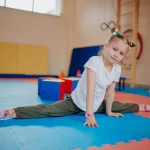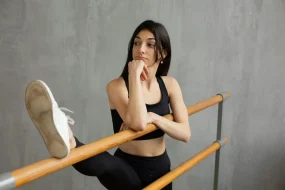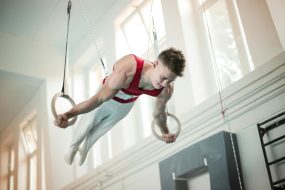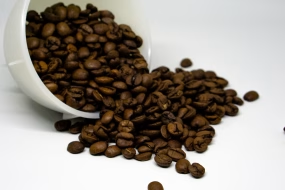Gymnastics is one of those sports where early starters often wow us on the Olympic stage. In fact, a surprising number of Olympic athletes were already carving cartwheels and balancing on beams before their fifth birthday. If you’ve ever wondered, “What is the best age to start gymnastics?” you’re definitely not the only parent grappling with the question. In this post, we’ll dive into the earliest age to safely dip a toe into the world of gymnastics, bust a few myths, share some key truths, and arm you with the knowledge you’ll need for your tiny tumblers in 2025.
Table of Contents
1. There’s No “One Size Fits All” Answer
There’s no gymnastics handbook that says every child must start by a certain date. Every little body is different. While some toddlers seem born to roll, others shine a few years later. Coaches and pediatric experts generally recommend a start date between ages 3 and 5. This is when little muscles are already flexing for jumping and balancing, and their brains are wiring together new skills faster than we can say “back handspring.”
Ultimately, the right age for your child will hinge on a few clues. Look for a mix of curiosity, mobility, and a willing spirit. If your 3-year-old is already joyfully shoulder-rolling across the living room rug, that’s your green light. If a 5-year-old is nervous and prefers balance on the ground, a little extra waiting is perfectly fine.
2. Moving Early Grows More Than Just Muscles
Gymnastics does more than stretch and strengthen. When kids start early, they also get to keep important life skills in their toolbox:
- Discipline: Following coaches and routines helps them feel organized.
- Confidence: Nailing a handstand or staying on the balance beam makes them feel proud.
- Teamwork: Even solo routines happen in a group, so kids learn to cheer and cooperate.
Pediatricians and child development specialists agree: kids in structured, active classes like gymnastics get better at moving their bodies and making friends. In short, gymnastics builds the body and the brain.
3. Best Age to Begin: Fun or Future Competition?
Is your child hoping to have fun and stay fit, or do you picture them on a medal stand someday? That question changes when to start gymnastics.
Recreational Gymnastics
Toddlers as young as 18 months can enjoy “Mommy & Me” classes that focus on movement games and simple skills. By age 3, many gyms offer classes kids can join without a parent. By 5, they can hop into a structured, standalone class.
During these early years, the focus stays on fun and basics: rolling, jumping, and balancing. There’s zero pressure, just happy giggles and steady growth.
Competitive Gymnastics
If your child wants trophies and medals, competitive gymnastics usually begins at age 6 or 7. That’s when most gyms create pre-team groups or start formal training. By this age, kids typically have the basic skills and the stamina to handle longer, more focused practices.
Some elite programs do look for talent even younger. Still, most kids can grow into competitive athletes if they start around age 7 or 8. Success then depends on their passion, how hard they are willing to work, and the support they get from family and coaches.
4. It’s Never Too Late to Try Gymnastics
You’ll love this: the best age to start gymnastics isn’t always “when you’re little.” Sure, younger kids have some advantages, but plenty of kids start in middle school or even high school and do great.
Older kids usually have more focus, better coordination, and a clearer sense of their bodies. These skills can actually give them a boost. And if you’re curious about gymnastics for yourself, many gyms offer adult classes, so it’s truly never too late to learn a new flip. If you want some fun movement ideas for you or your teen, check out the exercises we share here.
5. Every Gym Program is Unique—Do Your Homework
Not every gymnastics program is the same. Some gyms train kids for competitions while others focus on fitness and fun. Before you sign up, consider these questions:
- What’s the instructor-to-student ratio?
- Can we try a class before committing?
- When do you start more serious training?
- What safety measures are in place?
Visit the gym. Meet the coaches. Watch a class, if you can. Your child’s comfort and your own peace of mind are both key.
6. Watch for Readiness Signs
Still wondering what age is best? Sometimes your child gives you the answer:
- Do they love to jump, climb, and roll?
- Can they listen for a few minutes?
- Are they okay in groups?
- Do they stop to watch gymnastics on TV?
If you answer “yes” to most of these, your child may be ready to try gymnastics.
7. Support Matters More Than the Start Age
Wondering, “What is the best age to start gymnastics?” This year the answer is simple: whenever your child is excited. Little ones as young as 3 can giggle and roll in toddler classes, and kids aiming for competition often ramp up training at 6 or 7. Still, late starters show up at 8, 10, or even 13, bringing their hard work and talent. Coaches love that, too.
In 2025, the best milestone is not when they start, but how much they learn and laugh along the way. Begin at their speed. Cheer for every little step. Gymnastics is waiting—no matter if they’re decked in cute shoes at age 3 or in cool grips at age 13.
Are you excited for your child’s first cartwheel into something wonderful? Gymnastics isn’t just about dazzling flips and perfect splits. It’s about growing confidence, strength, and a love for moving joyfully, and it all starts with one happy somersault..
Final Takeaway
If you’ve been asking yourself, “What is the best age to start gymnastics?”, the answer is: it depends. Kids as young as 3 can join fun, structured programs, while many competitive athletes begin serious training around 6 or 7. Yet, there’s always room for late starters who bring heart and dedication to the mat.
In 2025, what truly matters isn’t when your child begins—but how they grow, learn, and enjoy the journey. Start where they are. Encourage progress, not perfection. The world of gymnastics is ready to welcome them, whether they’re walking into a gym at age three or thirteen.
So, are you ready to let your child take that first cartwheel toward something amazing? Remember, the journey into gymnastics isn’t just about flips and splits—it’s about building confidence, strength, and joyful movement, one somersault at a time.
Frequently Asked Questions
What’s the best age to start serious gymnastics training?
Most kids are ready for focused gymnastics around age 6 or 7. By this age, they’ve mastered basic movements and can enjoy longer practice times without getting too tired or frustrated.
Can toddlers really gain anything from gymnastics?
For sure! If the classes are age-appropriate, toddlers gain better motor skills, increased flexibility, and a fun early taste of teamwork and listening to a coach. Classes look a lot like playtime, just with a safe setup and gentle guidance.
Is gymnastics safe for young kids?
Yes, when a coach is trained, the right classes are chosen, and safety gear is used. Most injuries can be avoided if these safety steps are followed, so kids can enjoy gymnastics without worry.
Choosing the Right Class in 2025
Gymnastics classes are now more exciting than ever. In 2025, you can pick from ninja-style obstacle courses, classic artistic workouts, or acro-focused classes that mix dancing and flips. Pay attention to what your child enjoys. Let them sample a couple options and see which one makes their smile a little wider.
If the choices are giving you a headache, you’re in good company. Lots of parents like to know exactly what a class includes, when it meets, and what it costs. To help you avoid surprise bills, peek at this budget guide for kids’ sports before you click the signup button.










